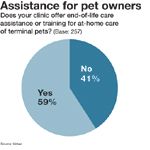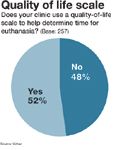Virbac's compassionate care survey probes end-of-life care practices
Dallas - Almost half of veterinarians surveyed are having end-of-life discussions with pet owners more than 11 times per month.
DALLAS — Almost half of the veterinarians surveyed are having end-of-life discussions with pet owners more than 11 times per month.
A recent "Compassionate Care Online Survey" from Virbac Animal Health sought to measure veterinarians and veterinary technicians attitudes and practices regarding euthanasia. The online survey achieved responses from 257 veterinarians (with an error margin of ±6.1 percent) and 148 veterinary technicians (with an error margin of ±7.8 percent).
Michael Walsh, Virbac's market development manager, reports that one of the survey's goals was to measure "some of the formalized policies that are out there regarding end-of-life care." Topics like communication, hospital procedures/practices and compassion fatigue were all addressed in the survey. As part of its effort to better understand current practices, an advisory council was assembled and asked to weigh in and talk about the issues surrounding end-of-life care for most veterinarians and veterinary technicians.

Discussions on at-home care
The council members included animal-health stalwarts Drs. Cindy Adams, Lisa Moses, Kathy Mitchener, Kelly Moffat, Kate Knutson, William Grant II and veterinary technician Katherine Dobbs.

Assistance for pet owners
This subject, according to Grant, is by far the most important discussion a veterinarian and client will ever have about the care of their pet. These are life-and-death decisions.

Quality of life scale
Some of the most frequently cited practices included offering to provide the pet owner with the pet's ashes (93 percent), use of sedation prior to administration of euthanasia drug (73 percent), offering a separate room for euthanasia (47 percent), preferred owners to be present (37 percent), grief counseling by clinic or off-site service (35 percent).

Euthanasia protocols
Some of the other findings included:
- 47 percent of veterinarian are having end-of-life discussions with clients more than 11 times per month.
- 59 percent of veterinarians surveyed say their hospital offers end-of-life assistance and training for pet owners with terminally ill pets.
- Only 12 percent of veterinary technicians receive euthanasia training.
- More than half (52 percent) of veterinarians say they use a quality-of-life scale for patients with terminal illnesses to help clients determine the decision to euthanize the animal.
- If the practice did use a scale, most of the respondents reported it was developed by the practitioners in the hospital or was a combination of published information and their own thinking.
- 53 percent of veterinarians report their hospitals perform euthanasias about 10 times a month.
The survey results showed some other interesting findings, like how integral the veterinary team is to end-of-life discussions and its procedures. In fact, about 79 percent of the veterinary technicians surveyed assist with euthanasia procedures. The majority of veterinary technicians (69 percent) personally have discussions with pet owners about the end-of-life care. In fact, veterinary technician responses very much aligned with veterinarian responses to this question.
What is less understood, Walsh says of the survey results, is a universal understanding of compassion fatigue. In fact, when asked, three-quarters of the veterinarians surveyed say they are aware of the term compassion fatigue, but fewer numbers of veterinarian respondents (64 percent) were familiar with the symptoms.
Respondents were then asked to identify possible symptoms seen in practice. About 90 percent said they have seen mental and physical tiredness, apathy/sadness (67 percent), difficulty concentrating (57 percent), preoccupation (51 percent), chronic physical ailments (46 percent), denial (31 percent) and isolation (31 percent).
Within hospitals, many members of the hospital team deal with euthanasia, and there are just as many different attitudes about performing or assisting with these end-of-life procedures.
"There are people who are really good at it. There are people who felt like they are really good at it, and there are people who don't want to deal with it at all. That was an eye opener for me– how much is not known out there," Walsh says.